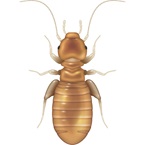Classification
Scientific name: Oryzaephilus surinamensis
Family: Silvanidae
Identification
There are 3 different species:1. Oryzaephilus surinamensis (dark brown beetle)
2. Oryzaephilus Mercator (Flat bark beetle)
3. Ahasverus advena (foreign grain beetle)
The grain beetle is a small insect with a slender, long body. The adults are 2.5-3.5 mm long, dark brown in colour with 6 teeth along each side of the prothorax (hence the name 'saw-toothed',
The grain beetle will inhabit grain at any point during processing, so are as common in farm storage as they are in retail storage. They are small active insects which readily exploit cracks and crevices where they can hide.
Symptoms
The larvae feed on the germ (embryo part of the seed) of damaged and broken grains (the supply of which increased with the advert of the combine harvester), so they can be regarded as secondary pests, and grains which are less vulnerable to attack.
Relatively small numbers of insects can rapidly give rise to serious infestations. They are small, active insects which are readily exploit cracks and crevices where they can hide.
Behaviour
One of the most common pests affecting stored grain products, it is a cold-hardy insect that can overwinter in temperate lands. The life-cycle completes in as little as 20 days and serious outbreaks may occur within a month of harvest.
Infestations often occur when grain is being transferred or in the fabric of grain stores (including sacks), and in vehicles used for transporting.
Risks
Small numbers of insects can rapidly give rise to serious infestations. The species will infest cereals and a wide range of foodstuffs; they frequently appear in packaged foods.
Generally, they infest damaged grains and use small lesions in the grain to attack it. Their presence in grain may result in its rejection.
The foreign grain beetle is capable of infesting a variety of materials but only in the presence of moulds.
When infestations in stores become heavy they cause the grain to heat. This in turn leads to caking, moulding and even sprouting. Both the quality and weight of the grain may be reduced.
Life-cycle
The female saw-toothed grain beetle lays up to 400 eggs, either singly or in small batches, at a rate of 6-10 per day. These are laid in, or adjacent to, a suitable food supply and at a temperature of 20-23 °C hatch in 8-17 days to give flattened larvae about 0.9 mm long.
They are yellowish/white in colour, with brown flecks and a brown head. Typical of coleoterous larvae, they have a well-developed head, biting mouthparts and 3 pairs of legs on the thoracic segments.
The larval sage lasts 4-7 weeks during which the larvae go through 2-5 moults, attaining a length of 3 mm. They then construct a cell of food particles and other debris in which to pupate, emerging after 1-3 weeks as adults.
On emergence the adult beetles live for 6-10 months, breeding within a temperature range of 17.5-40 °C.
At 20 °C the full life-cycle is completed in 12-15 weeks whilst at 32-35 °C it takes only 20 days.
Although they originate from tropical climates, they are sufficiently cold-hardy to be able to overwinter in crevices in unheated buildings.















